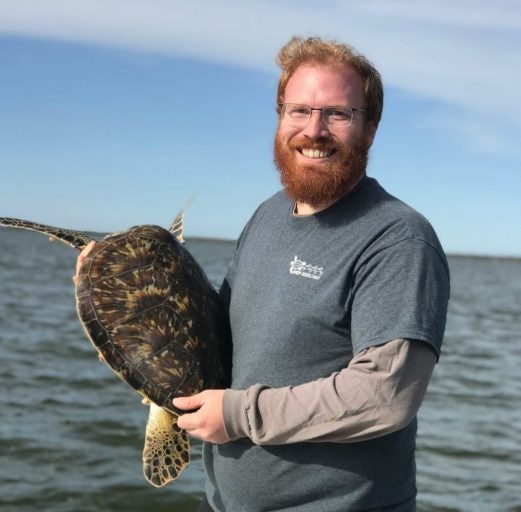Long before the algal blooms on Florida’s Gulf Coast sparked surprise and outrage, University of Central Florida doctoral student Chris Long was studying the effects of similar episodes on threatened green sea turtles in the Indian River Lagoon.
Algae blooms regularly hit the Indian River Lagoon and were especially intense from 2011 to 2013. The lagoon is an important foraging area along the eastern Florida coast for juvenile green turtles.
The blooms, likely caused by excess nutrients in the lagoon, choke the lagoon by blocking light from reaching through the water and by using up the oxygen in the water. That leads to the death of sea grass, fish and other creatures in the lagoon, which in turn causes a stink and upper respiratory issues for some people. Recently, the lagoon also endured two raw-sewage dumps, according to new stories.
A grant funded through the sea turtle license plate gave Long the opportunity to use stable isotope analysis to study the turtle population. Long is part of UCF’s Marine Turtle Research Group, which has been monitoring sea turtles along the eastern part of the state for more than four decades. In addition to monitoring the beaches during sea turtle nesting season, the group twice a month studies the turtles in the lagoon. Turtles are collected, measured, checked for fibropapillomatosis tumors and given a general health assessment before being returned to the lagoon.
This summer, Long began using stable isotope analysis on turtle and fish samples collected from the lagoon from 2011 to2017. The results will give Long a better idea of what and where the turtles were eating before and after the blooms.
“The impact isn’t very well understood,” he said. “When it came to algal blooms, I saw an opportunity to highlight how the impacts on turtles result from broader ecological problems, and an opportunity to spread awareness of these problems. Just as excess nutrients from fertilizer and septic tanks helped cause the blooms in the Indian River Lagoon, they have likely made the red tides worse in the Gulf of Mexico. Hopefully my work can help lead to fewer and smaller blooms in the future.”
While Long hasn’t finished his analysis, the early data indicates decreases in the number of turtles in the lagoon in 2011-13, the years when the lagoon experienced superblooms and brown tide events. “We don’t think those blooms killed turtles, so stable isotope analysis can help us understand whether their habitat use and diet changed in response to the blooms,” he said.
Why that exactly happened and what it means for the future of sea turtles is exactly what Long and his colleagues want to find out.
“The goal is to understand how turtles respond to rapid changes in their habitats and use that information to protect turtles more effectively,” Long said. “The changes aren’t likely to go away in the short term, so now we need to focus on how to respond.”
